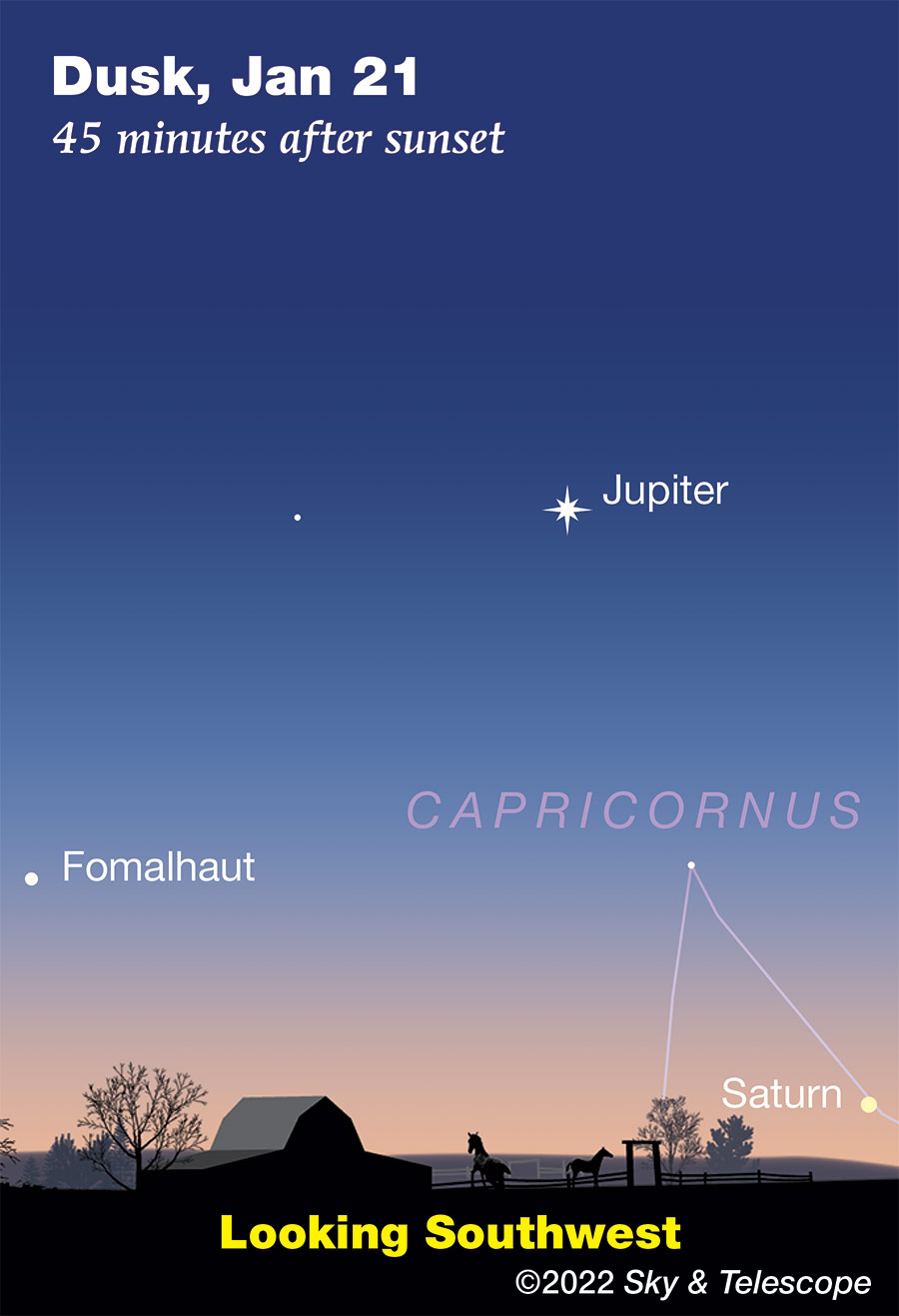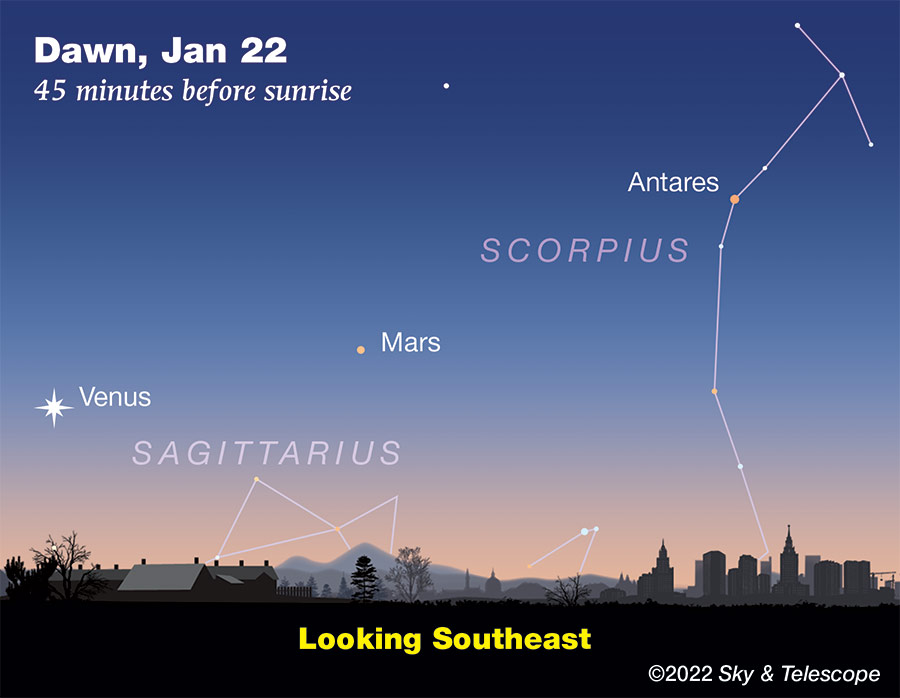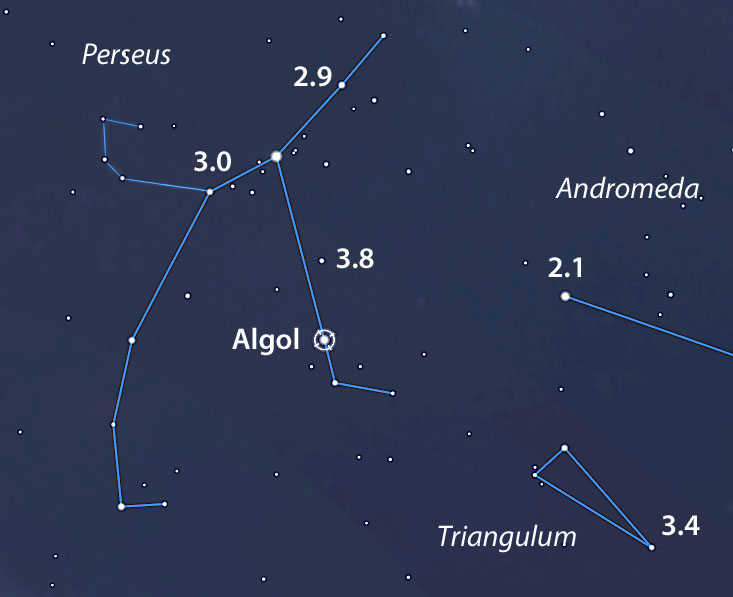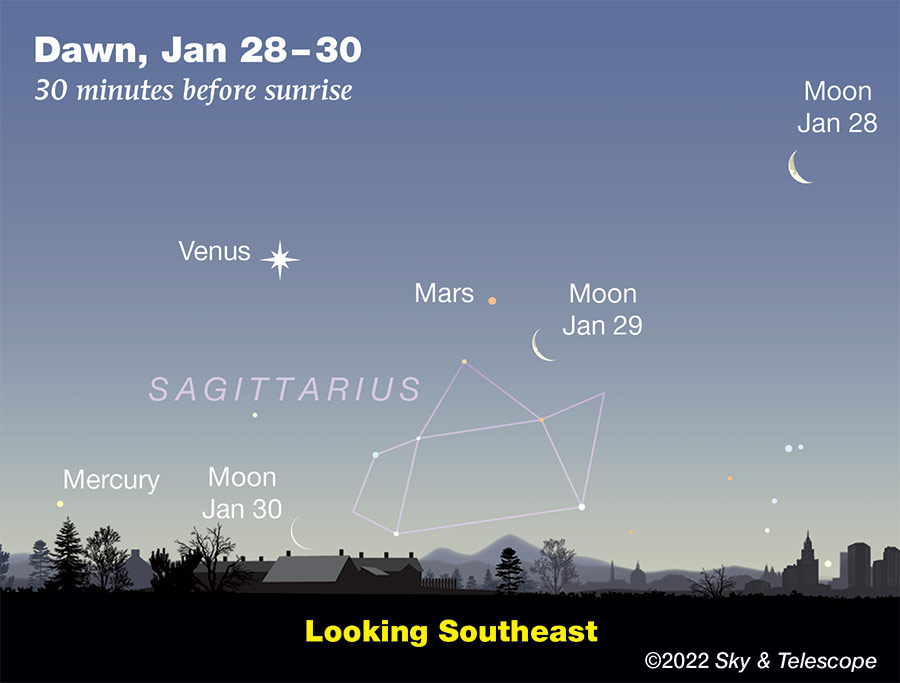FRIDAY, JANUARY 21
■ Jupiter still shines brightly in the southwest at dusk, though lower each week. It makes a perfectly nice, if second-place, "Evening Star" now that Venus has departed.
Fomalhaut still twinkles 20° (about two fists at arm's length) to Jupiter's lower left. The farther south you are, the less low you'll have to look to catch Fomalhaut in late twilight.


■ The early-evening sky is dark now until the waning Moon rises about 9 p.m. Is your sky dark enough for you to see the winter Milky Way? After dinnertime it runs vertically from Canis Major low in the southeast, up between Orion and Gemini, through Auriga and Perseus overhead, and down through Cassiopeia, Cepheus, and Cygnus to the northwest horizon.
■ Iris in Gemini. The asteroid 7 Iris, magnitude 7.8. is just a week past opposition and nicely placed high in the east by 7 or 8 p.m. It's in Gemini under the Pollux stick-figure twin, and above Procyon. Bring your telescope or large binoculars and the finder chart in the January Sky & Telescope, page 49.
Note: The date ticks on that chart, like on all of S&T's asteroid and comet charts, mark 0:00 Universal Time for the dates indicated. In North America this moment falls in the early evening of the previous date.
Unsure how to relate what you see on the chart to what you see (or don't) in your finderscope or eyepiece? The essential tricks you need await you in How to Use a Star Chart with a Telescope. They apply just as much to a chart onscreen as to a chart on paper.
SATURDAY, JANUARY 22
■ Zero-magnitude Capella high overhead, and equally bright Rigel in Orion's foot, have almost the same right ascension. This means they cross your sky’s meridian at almost exactly the same time: around 9 p.m. now, depending on how far east or west you live in your time zone. So whenever Capella passes its very highest, Rigel always marks true south over your landscape, and vice versa.
Capella goes exactly through your zenith if you're at latitude 46° north: Portland, Oregon; Montreal; central France.
■ High overhead, the prototype eclipsing binary star Algol should be at its minimum brightness, magnitude 3.4 instead of its usual 2.1, for a couple hours centered on 8:46 p.m. EST. Algol takes several additional hours to fade and to rebrighten. You can always compare it at a glance to nearby Gamma Andromedae (Andromeda's bright foot), magnitude 2.1.

On all our star maps north is up, east is left.
SUNDAY, JANUARY 23
■ Orion is now high in the southeast right after dark, and he stands highest due south around 9 p.m. Orion is the brightest and showiest of the 88 constellations — and that often distracts from the fact that his main pattern is surprisingly small compared to some of his dimmer neighbors. The biggest of these is Eridanus the River to his west, enormous but hard to trace. Dimmer Fornax the Furnace, to Eridanus's lower right, is almost as big as Orion! Even the main pattern of Lepus, the Hare cowering under Orion's feet, isn't much smaller than he is. Compared to Orion, the rabbit is the size of a Saint Bernard.
MONDAY, JANUARY 24
■ The last-quarter Moon rises around midnight tonight. Once it's up, look for Spica roughly a fist to its upper right, and brighter Arcturus three fists to their upper left.
By early dawn Tuesday morning the Moon is high in the south, now with Spica to its right and Arcturus above it. The Moon is exactly last-quarter at 8:41 a.m. Tuesday morning EST (5:51 a.m. Pacific). At that time it's in view throughout North America, whether in darkness or daylight.
TUESDAY, JANUARY 25
■ Sirius twinkles brightly after dinnertime below Orion in the southeast. Around 8 p.m., depending on your location, Sirius shines precisely below fiery Betelgeuse in Orion's shoulder. How accurately can you time this event for your location, perhaps judging against the vertical edge of a building? Earlier in the evening, Sirius leads. Later in the evening, Betelgeuse leads.
WEDNESDAY, JANUARY 26
■ After dark, face east and look very high. The bright star there is Capella, the Goat Star. To the right of it, by a couple of finger-widths at arm's length, is a small, narrow triangle of 3rd and 4th magnitude stars known as "the Kids." Though they're not exactly eye-grabbing, they form a never-forgotten asterism with Capella.
THURSDAY, JANUARY 27
■ The big Northern Cross in Cygnus, topped by Deneb, stands nearly upright over the northwest horizon after dark. As evening grows late it sinks to the horizon and on down into it, like a sword plunging into the ground.
FRIDAY, JANUARY 28
■ Right after dark, face east and look very high, almost straight up. The bright star there is Capella, the Goat Star. To the right of it, by a couple of finger-widths at arm's length, is a small, narrow triangle of 3rd- and 4th-magnitude stars known as "The Kids." Though they're not exactly eye-grabbing, they form a never-forgotten asterism with Capella.

SATURDAY, JANUARY 29
■ Spot the equilateral Winter Triangle in the southeast. Sirius is its brightest and lowest star. Betelgeuse stands above Sirius by about two fists at arm's length. To the left of their midpoint is Procyon.
Can you discern their colors? Sirius (spectral type A0) is cold white, Betelgeuse (M2) is pale orange, and Procyon (F5) is much paler yellowish white.
And, standing 4° above Procyon is 3rd-magnitude Gomeisa, or Beta Canis Minoris, the only other easy naked-eye star of Canis Minor.
■ Meanwhile, the Great Square of Pegasus is sinking low in the west, tipped onto one corner. And the Big Dipper is creeping up in the north-northeast, tipped up on its handle.
This Week's Planet Roundup
Mercury and Saturn have ridden away into the sunset.
Venus (magnitude –4.6) is climbing up into the dawn. Look for it low in the east-southeast in early dawn. In a telescope or even good binoculars it's a crescent, thickening and shrinking each week.
Mars, vastly fainter at magnitude +1.4, is low in the southeast in early dawn to the right of Venus. They're 15° apart on the morning of January 22nd, closing to 10° on the 29th (when the thin Moon shines near Mars). Brighter, Mars-colored Antares in Scorpius shines far to the upper right. See illustrations above.
Both Venus and Mars are in Sagittarius. Stars of the Teapot are below them.
Mars is on the far side of its orbit from us, so in a telescope it's just a tiny blob 4.2 arcseconds wide.
Jupiter (magnitude –2.0, in Aquarius) still shines brightly in the southwest at dusk, lower every week.
Uranus (magnitude 5.7, in Aries) is very high in the south in early evening. Finder chart.
Neptune (magnitude 7.9, in Aquarius) is much lower in the southwest after dark, some 16° upper left of Jupiter. It's invisible without optical aid and a good finder chart.
All descriptions that relate to your horizon — including the words up, down, right, and left — are written for the world's mid-northern latitudes. Descriptions and graphics that also depend on longitude (mainly Moon positions) are for North America.
Eastern Standard Time, EST, is Universal Time (also called UT, UTC, GMT, or Z time) minus 5 hours.
Want to become a better astronomer? Learn your way around the constellations. They're the key to locating everything fainter and deeper to hunt with binoculars or a telescope.
This is an outdoor nature hobby. For an easy-to-use constellation guide covering the whole evening sky, use the big monthly map in the center of each issue of Sky & Telescope, the essential magazine of astronomy.
Once you get a telescope, to put it to good use you'll need a detailed, large-scale sky atlas (set of charts). The basic standard is the Pocket Sky Atlas (in either the original or Jumbo Edition), which shows stars to magnitude 7.6.

Next up is the larger and deeper Sky Atlas 2000.0, plotting stars to magnitude 8.5; nearly three times as many. The next up, once you know your way around, are the even larger Interstellarum atlas (stars to magnitude 9.5) or Uranometria 2000.0 (stars to magnitude 9.75). And be sure to read How to Use a Star Chart with a Telescope. Yes, it applies just as much to charts onscreen as to charts on paper.
You'll also want a good deep-sky guidebook. An impressive one is the big Night Sky Observer's Guide set (2+ volumes) by Kepple and Sanner.
Can a computerized telescope replace charts? Not for beginners, I don't think, and not on mounts and tripods that are less than top-quality mechanically, meaning heavy and expensive. And as Terence Dickinson and Alan Dyer say in their Backyard Astronomer's Guide, "A full appreciation of the universe cannot come without developing the skills to find things in the sky and understanding how the sky works. This knowledge comes only by spending time under the stars with star maps in hand."
![]() Audio sky tour. Out under the evening sky with your
Audio sky tour. Out under the evening sky with your
earbuds in place, listen to Kelly Beatty's monthly
podcast tour of the heavens above. It's free.
"The dangers of not thinking clearly are much greater now than ever before. It's not that there's something new in our way of thinking, it's that credulous and confused thinking can be much more lethal in ways it was never before."
— Carl Sagan, 1996
"Facts are stubborn things."
— John Adams, 1770
*Answer to why Mars is tiny and faint when near Venus. Seen from Earth, Venus always appears fairly near the Sun in our sky. That's because it orbits closer to the Sun than we do.
But Mars orbits farther out from the Sun than we do. That means that whenever Mars appears near our line of sight to the Sun (its only chance to appear near Venus), Mars is on the far side of its orbit from us. And that means it's about as distant and tiny as it can get.
 7
7









Comments
Rod
January 21, 2022 at 9:51 am
I did some lunar observing last night motivated by Bob King's report, https://skyandtelescope.org/astronomy-news/set-your-sights-on-this-lunar-bulls-eye/
Observation note placed there.
You must be logged in to post a comment.
Rod
January 22, 2022 at 9:20 pm
Some difficult winter observing tonight from MD. [Observed 1730-2000 EST/2230-0100 UT. Last Quarter Moon 25-Jan-2022 1341 UT. Waning gibbous Moon rise at 2205 EST/0305 UT. I tried to observe tonight but altocumulus clouds did not cooperate. Only brief views of Capella using the 10-inch at 34x with 35-mm eyepiece. Occasionally, Capella was visible during breaks in the clouds. The 10-inch picked up various stars in the 10th-12th apparent magnitude range that Stellarium 0.21.3 and Starry Night Pro Plus 8 shows, most 10-20 arcminutes angular separation from Capella. This was earlier in the evening. A good example, TYC3358-1670-1. Starry Night reports 11.53 apparent magnitude, so does the SIMBAD portal. I was able to view M42 using the 90-mm refractor telescope at 71x with 14-mm eyepiece. M42 difficult because I observed through altocumulus clouds, but I did see 4 stars in the Trapezium and nebulosity during brief breaks in the clouds. I thought it was to be mostly clear, but clouds did not cooperate, so I packed it up. Temperature -4C, the wood burning stove felt very good when I came back inside.]
You must be logged in to post a comment.
mary beth
January 24, 2022 at 1:15 pm
Two good reports Rod, thanks for your posts. I appreciate the link to Bob King’s page; that was fantastic information. Very nice you were able to enjoy this rare event. Were some of stars near Capella that you were able to see during the cloud breaks considered to be ‘the kids’ mentioned in this post? I don’t think I’ve ever read about them before this year’s column. Fun stuff!
You must be logged in to post a comment.
Rod
January 24, 2022 at 5:59 pm
mary beth, 'the Kids', no I did not see using the telescope. These 3 stars discussed are about 3 to 5.5 degrees angular separation from Capella. You can see these with unaided eyes and binocular views. Perhaps this Wednesday will be better and clear skies for me, and colder with temps down in the teens (F) again.
You must be logged in to post a comment.
Rod
January 24, 2022 at 7:02 pm
mary beth, the skies are clearer for me now. I just went out and viewed Capella and 'the Kids' unaided eyes 🙂 Indeed this report, "Though they're not exactly eye-grabbing, they form a never-forgotten asterism with Capella." is good 🙂 It is fun to see this stellar pattern near Capella. Stellarium 0.21.3 shows the star names, Almaaz, Haedus I, and Haedus II.
You must be logged in to post a comment.
mary beth
January 26, 2022 at 11:25 pm
Glad you have clear skies, we do here as well! I’m so fascinated by the names the ancient cultures gave the stars and constellations and asterisms. They are all so fitting given the season, and nearby stars; such as Virgo, with the grain of wheat Spica near Corvus the crow. They really tell a story!
I believe I saw Regulus last night rising in the east!
You must be logged in to post a comment.
Rod
January 27, 2022 at 7:45 am
I will post my binocular and telescope observations from last night tomorrow morning. This morning, very lovely views of Venus and the Moon using unaided eyes.
Observed 0610-0625 EST/1110-1125 UT. Lovely unaided eye views of earthshine and waning crescent Moon in Scorpius and Venus in Sagittarius this morning. Temperature -11C, winds NW 3 knots. Clear skies.
You must be logged in to post a comment.
You must be logged in to post a comment.